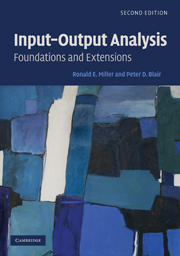Book contents
- Frontmatter
- Contents
- List of Figures
- List of Tables
- Preface
- 1 Introduction and Overview
- 2 Foundations of Input–Output Analysis
- 3 Input–Output Models at the Regional Level
- 4 Organization of Basic Data for Input–Output Models
- 5 The Commodity-by-Industry Approach in Input–Output Models
- 6 Multipliers in the Input–Output Model
- 7 Nonsurvey and Partial-Survey Methods: Fundamentals
- 8 Nonsurvey and Partial-Survey Methods: Extensions
- 9 Energy Input–Output Analysis
- 10 Environmental Input–Output Analysis
- 11 Social Accounting Matrices
- 12 Supply-Side Models, Linkages, and Important Coefficients
- 13 Structural Decomposition, Mixed and Dynamic Models
- 14 Additional Topics
- Appendix A Matrix Algebra for Input–Output Models
- Appendix B Reference Input–Output Tables for the United States (1919–2006)
- Appendix C Historical Notes on the Development of Leontief's Input–Output Analysis
- Author Index
- Subject Index
11 - Social Accounting Matrices
Published online by Cambridge University Press: 05 June 2012
- Frontmatter
- Contents
- List of Figures
- List of Tables
- Preface
- 1 Introduction and Overview
- 2 Foundations of Input–Output Analysis
- 3 Input–Output Models at the Regional Level
- 4 Organization of Basic Data for Input–Output Models
- 5 The Commodity-by-Industry Approach in Input–Output Models
- 6 Multipliers in the Input–Output Model
- 7 Nonsurvey and Partial-Survey Methods: Fundamentals
- 8 Nonsurvey and Partial-Survey Methods: Extensions
- 9 Energy Input–Output Analysis
- 10 Environmental Input–Output Analysis
- 11 Social Accounting Matrices
- 12 Supply-Side Models, Linkages, and Important Coefficients
- 13 Structural Decomposition, Mixed and Dynamic Models
- 14 Additional Topics
- Appendix A Matrix Algebra for Input–Output Models
- Appendix B Reference Input–Output Tables for the United States (1919–2006)
- Appendix C Historical Notes on the Development of Leontief's Input–Output Analysis
- Author Index
- Subject Index
Summary
Introduction
The System of National Accounts (SNA) described in Chapter 4 was developed from the basic concepts of the circular flow of income and expenditures in an economy. As noted in that chapter, the SNA provides a convenient and essentially standardized framework for compiling and organizing aggregate national statistics that characterize the economic profile of an economy. When the SNA s combined with the Input–Output accounts, which incorporate the interindustry activity associated with intermediate as well as final production and consumption of goods and services in the economy, the picture of the economy becomes more comprehensive. However, the framework as t has been developed so far in this text provides relatively little insight into the role of people and social institutions in the economy, e.g., labor and households, human capital, and social welfare.
Alogical goal then, and the focus of this chapter, is to extend the SNA/IO framework to add a more detailed characterization of the roles of labor, households, and the social institutions of the economy. In particular, we seek to capture in more detail the employment features of the economy, including such factors as income from employment and its disposition, labor costs, and the demographics of the work force that comprise the market for supply and demand of labor. Moreover, in many nations' compilations of national statistics, no framework exists to ensure consistency across statistics from various sources, let alone reconciling them with basic economic accounts. Both goals can be accomplished by means of a so-called Social Accounting Matrix (SAM), development of which is the principal focus of this chapter.
- Type
- Chapter
- Information
- Input-Output AnalysisFoundations and Extensions, pp. 499 - 542Publisher: Cambridge University PressPrint publication year: 2009



